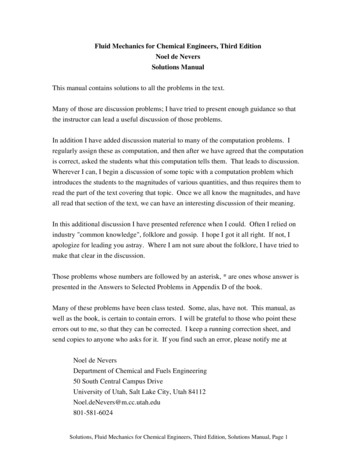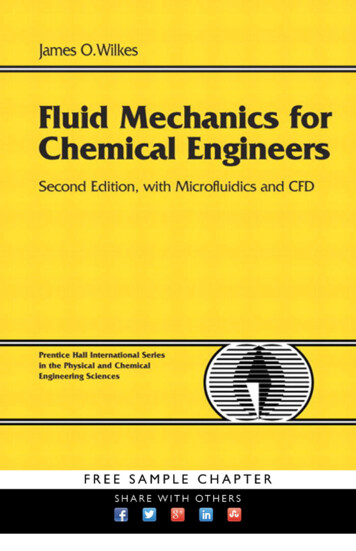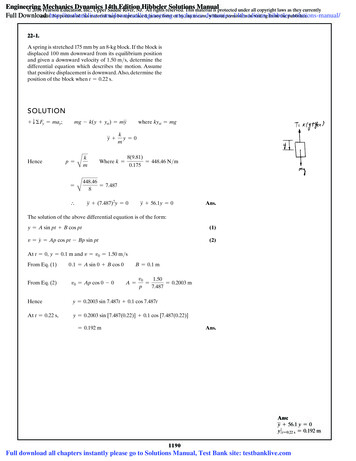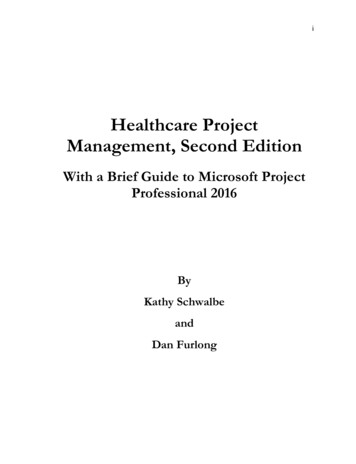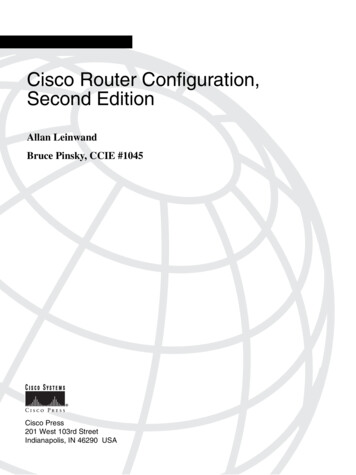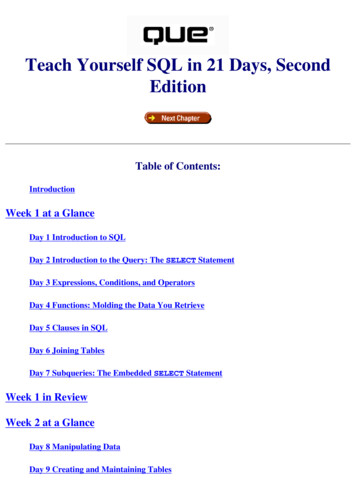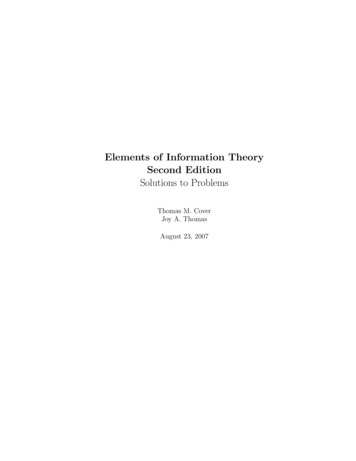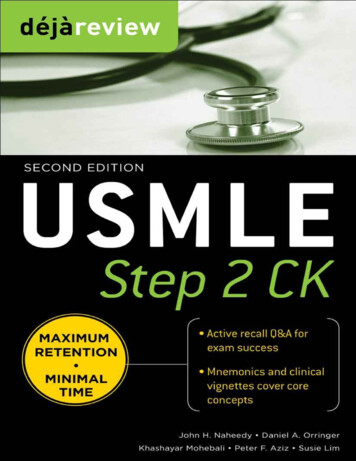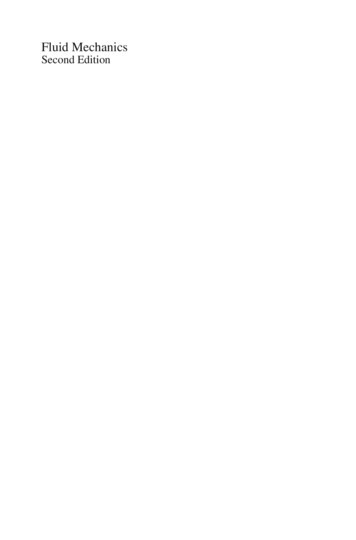
Transcription
Fluid MechanicsSecond Edition
Joseph H. Spurk · Nuri AkselFluid MechanicsSecond Edition123
Professor Dr. Joseph H. Spurk (em.)TU DarmstadtInstitut für Technische StrömungslehrePetersenstraße 3064287 DarmstadtGermanyISBN 978-3-540-73536-6Professor Dr. Nuri AkselUniversität BayreuthLehrstuhl für Technische Mechanikund StrömungsmechanikUniversitätsstraße 3095447 BayreuthGermanye-ISBN 978-3-540-73537-3DOI 10.1007/978-3-540-73537-3Library of Congress Control Number: 2007939489 2008, 1997 Springer-Verlag Berlin HeidelbergThis work is subject to copyright. All rights are reserved, whether the whole or part of the material isconcerned, specifically the rights of translation, reprinting, reuse of illustrations, recitation, broadcasting,reproduction on microfilm or in any other way, and storage in data banks. Duplication of this publicationor parts thereof is permitted only under the provisions of the German Copyright Law of September 9,1965, in its current version, and permission for use must always be obtained from Springer. Violationsare liable for prosecution under the German Copyright Law.The use of general descriptive names, registered names, trademarks, etc. in this publication does notimply, even in the absence of a specific statement, that such names are exempt from the relevant protectivelaws and regulations and therefore free for general use.Typesetting and Production: LE-TEX Jelonek, Schmidt & Vöckler GbR, Leipzig, GermanyCover design: eStudioCalamar S.L., F. Steinen-Broo, Girona, SpainPrinted on acid-free paper987654321springer.com
Preface to the First English EditionThis textbook is the translation of the fourth edition of Strömungslehre, Einführung in die Theorie der Strömungen. The German edition has met witha favorable reception in German-speaking countries, showing that there wasa demand for a book that emphazises the fundamentals. In the English literature there are books of the same nature, some excellent, and these haveindeed influenced me to write this book. However, they cover different groundand are not aimed primarily at mechanical engineering students, which thisbook is. I have kept the original concept throughout all editions and there islittle to say that has not been said in the preface to the first German edition.There is now a companion volume Solved Problems in Fluid Mechanics, whichalleviates the drawback of the first German edition, namely the absence ofproblem exercises.The book has been translated by Katherine Mayes during her stay inDarmstadt, and I had the opportunity to work with her daily. It is for thisreason that I am solely responsible for this edition, too. My thanks also goto Prof. L. Crane from Trinity College in Dublin for his assistance with thisbook. Many people have helped, all of whom I cannot name, but I wouldlike to express my sincere thanks to Ralf Münzing, whose dependable andunselfish attitude has been a constant encouragement during this work.Darmstadt, January 1997J. H. SpurkPreface to the Second English EditionThe first English edition was the translation of the fourth German edition. Inthe meantime the textbook has undergone several additions, mostly stimulated by consulting activities of the first author. Since the textbook continuesto receive favourable reception in German speaking countries and has beentranslated in other languages as well, the publisher suggested a second Englishedition. The additions were translated for the most part by Prof. L. Cranefrom Trinity College in Dublin, who has accompanied this textbook fromthe very beginning. Since the retirement of the first author, Prof. N. Akselfrom the University of Bayreuth, Germany, the second author, was activelyengaged in the sixth and the seventh edition. The additions were written bythe first author who accepts the responsibility for any mistakes or omissionsin this book.
Contents12The Concept of the Continuum and Kinematics . . . . . . . . . .1.1 Properties of Fluids, Continuum Hypothesis . . . . . . . . . . . . . . .1.2 Kinematics . . . . . . . . . . . . . . . . . . . . . . . . . . . . . . . . . . . . . . . . . . . .1.2.1 Material and Spatial Descriptions . . . . . . . . . . . . . . . . . .1.2.2 Pathlines, Streamlines, Streaklines . . . . . . . . . . . . . . . . .1.2.3 Differentiation with Respect to Time . . . . . . . . . . . . . . .1.2.4 State of Motion, Rate of Change of Line, Surfaceand Volume Elements . . . . . . . . . . . . . . . . . . . . . . . . . . . .1.2.5 Rate of Change of Material Integrals . . . . . . . . . . . . . . .Fundamental Laws of Continuum Mechanics . . . . . . . . . . . . . .2.1 Conservation of Mass, Equation of Continuity . . . . . . . . . . . . . .2.2 Balance of Momentum . . . . . . . . . . . . . . . . . . . . . . . . . . . . . . . . . .2.3 Balance of Angular Momentum . . . . . . . . . . . . . . . . . . . . . . . . . .2.4 Momentum and Angular Momentumin an Accelerating Frame . . . . . . . . . . . . . . . . . . . . . . . . . . . . . . . .2.5 Applications to Turbomachines . . . . . . . . . . . . . . . . . . . . . . . . . . .2.6 Balance of Energy . . . . . . . . . . . . . . . . . . . . . . . . . . . . . . . . . . . . . .2.7 Balance of Entropy . . . . . . . . . . . . . . . . . . . . . . . . . . . . . . . . . . . . .2.8 Thermodynamic Equations of State . . . . . . . . . . . . . . . . . . . . . . .1177101417293535374446546569713Constitutive Relations for Fluids . . . . . . . . . . . . . . . . . . . . . . . . . 754Equations of Motion for Particular Fluids . . . . . . . . . . . . . . . .4.1 Newtonian Fluids . . . . . . . . . . . . . . . . . . . . . . . . . . . . . . . . . . . . . . .4.1.1 The Navier-Stokes Equations . . . . . . . . . . . . . . . . . . . . . .4.1.2 Vorticity Equation . . . . . . . . . . . . . . . . . . . . . . . . . . . . . . .4.1.3 Effect of Reynolds’ Number . . . . . . . . . . . . . . . . . . . . . . .4.2 Inviscid Fluids . . . . . . . . . . . . . . . . . . . . . . . . . . . . . . . . . . . . . . . . .4.2.1 Euler’s Equations . . . . . . . . . . . . . . . . . . . . . . . . . . . . . . . .4.2.2 Bernoulli’s Equation . . . . . . . . . . . . . . . . . . . . . . . . . . . . . .4.2.3 Vortex Theorems . . . . . . . . . . . . . . . . . . . . . . . . . . . . . . . .4.2.4 Integration of the Energy Equation . . . . . . . . . . . . . . . . .4.3 Initial and Boundary Conditions . . . . . . . . . . . . . . . . . . . . . . . . .4.4 Simplification of the Equations of Motion . . . . . . . . . . . . . . . . . .95959598100106106107112138141145
VIIIContents5Hydrostatics . . . . . . . . . . . . . . . . . . . . . . . . . . . . . . . . . . . . . . . . . . . . . .5.1 Hydrostatic Pressure Distribution . . . . . . . . . . . . . . . . . . . . . . . .5.2 Hydrostatic Lift, Force on Walls . . . . . . . . . . . . . . . . . . . . . . . . . .5.3 Free Surfaces . . . . . . . . . . . . . . . . . . . . . . . . . . . . . . . . . . . . . . . . . .1511511561626Laminar Unidirectional Flows . . . . . . . . . . . . . . . . . . . . . . . . . . . .6.1 Steady Unidirectional Flow . . . . . . . . . . . . . . . . . . . . . . . . . . . . . .6.1.1 Couette Flow . . . . . . . . . . . . . . . . . . . . . . . . . . . . . . . . . . . .6.1.2 Couette-Poiseuille Flow . . . . . . . . . . . . . . . . . . . . . . . . . . .6.1.3 Flow Down an Inclined Plane . . . . . . . . . . . . . . . . . . . . . .6.1.4 Flow Between Rotating Concentric Cylinders . . . . . . . .6.1.5 Hagen-Poiseuille Flow . . . . . . . . . . . . . . . . . . . . . . . . . . . .6.1.6 Flow Through Noncircular Conduits . . . . . . . . . . . . . . . .6.2 Unsteady Unidirectional Flows . . . . . . . . . . . . . . . . . . . . . . . . . . .6.2.1 Flow Due to a Wall Which Oscillatesin its Own Plane . . . . . . . . . . . . . . . . . . . . . . . . . . . . . . . . .6.2.2 Flow Due to a Wall Which is Suddenly Set in Motion6.3 Unidirectional Flows of Non-Newtonian Fluids . . . . . . . . . . . . .6.3.1 Steady Flow Through a Circular Pipe . . . . . . . . . . . . . .6.3.2 Steady Flow Between a Rotating Diskand a Fixed Wall . . . . . . . . . . . . . . . . . . . . . . . . . . . . . . . .6.3.3 Unsteady Unidirectional Flowsof a Second Order Fluid . . . . . . . . . . . . . . . . . . . . . . . . . .6.4 Unidirectional Flows of a Bingham Material . . . . . . . . . . . . . . .6.4.1 Channel Flow of a Bingham Material . . . . . . . . . . . . . . .6.4.2 Pipe Flow of a Bingham Material . . . . . . . . . . . . . . . . . .1671681681691711741751801837Fundamentals of Turbulent Flow . . . . . . . . . . . . . . . . . . . . . . . . . .7.1 Stability and the Onset of Turbulence . . . . . . . . . . . . . . . . . . . . .7.2 Reynolds’ Equations . . . . . . . . . . . . . . . . . . . . . . . . . . . . . . . . . . . .7.3 Turbulent Shear Flow Near a Wall . . . . . . . . . . . . . . . . . . . . . . . .7.4 Turbulent Flow in Smooth Pipes and Channels . . . . . . . . . . . . .7.5 Turbulent Flow in Rough Pipes . . . . . . . . . . . . . . . . . . . . . . . . . .2052052072132232268Hydrodynamic Lubrication . . . . . . . . . . . . . . . . . . . . . . . . . . . . . . .8.1 Reynolds’ Equation of Lubrication Theory . . . . . . . . . . . . . . . . .8.2 Statically Loaded Bearing . . . . . . . . . . . . . . . . . . . . . . . . . . . . . . .8.2.1 Infinitely Long Journal Bearing . . . . . . . . . . . . . . . . . . . .8.2.2 Infinitely Short Journal Bearing . . . . . . . . . . . . . . . . . . .8.2.3 Journal Bearing of Finite Length . . . . . . . . . . . . . . . . . . .8.3 Dynamically Loaded Bearings . . . . . . . . . . . . . . . . . . . . . . . . . . . .8.3.1 Infinitely Long Journal Bearing . . . . . . . . . . . . . . . . . . . .8.3.2 Dynamically Loaded Slider Bearing . . . . . . . . . . . . . . . .8.3.3 Squeeze Flow of a Bingham Material . . . . . . . . . . . . . . .8.4 Thin-Film Flow on a Semi-Infinite Wall . . . . . . . . . . . . . . . . . . 91197197202
ContentsIX8.5 Flow Through Particle Filters . . . . . . . . . . . . . . . . . . . . . . . . . . . . 2528.6 Flow Through a Porous Medium . . . . . . . . . . . . . . . . . . . . . . . . . 2548.7 Hele-Shaw Flows . . . . . . . . . . . . . . . . . . . . . . . . . . . . . . . . . . . . . . . 2589Stream Filament Theory . . . . . . . . . . . . . . . . . . . . . . . . . . . . . . . . . .9.1 Incompressible Flow . . . . . . . . . . . . . . . . . . . . . . . . . . . . . . . . . . . .9.1.1 Continuity Equation . . . . . . . . . . . . . . . . . . . . . . . . . . . . . .9.1.2 Inviscid Flow . . . . . . . . . . . . . . . . . . . . . . . . . . . . . . . . . . . .9.1.3 Viscous Flow . . . . . . . . . . . . . . . . . . . . . . . . . . . . . . . . . . . .9.1.4 Application to Flows with Variable Cross-Section . . . .9.1.5 Viscous Jet . . . . . . . . . . . . . . . . . . . . . . . . . . . . . . . . . . . . . .9.2 Steady Compressible Flow . . . . . . . . . . . . . . . . . . . . . . . . . . . . . . .9.2.1 Flow Through Pipes and Ductswith Varying Cross-Section . . . . . . . . . . . . . . . . . . . . . . . .9.2.2 Constant Area Flow . . . . . . . . . . . . . . . . . . . . . . . . . . . . . .9.2.3 The Normal Shock Wave Relations . . . . . . . . . . . . . . . . .9.3 Unsteady Compressible Flow . . . . . . . . . . . . . . . . . . . . . . . . . . . . .26126126226326627127627910 Potential Flows . . . . . . . . . . . . . . . . . . . . . . . . . . . . . . . . . . . . . . . . . . .10.1 One-Dimensional Propagation of Sound . . . . . . . . . . . . . . . . . . .10.2 Steady Compressible Potential Flow . . . . . . . . . . . . . . . . . . . . . .10.3 Incompressible Potential Flow . . . . . . . . . . . . . . . . . . . . . . . . . . . .10.3.1 Simple Examples of Potential Flows . . . . . . . . . . . . . . . .10.3.2 Virtual Masses . . . . . . . . . . . . . . . . . . . . . . . . . . . . . . . . . .10.4 Plane Potential Flow . . . . . . . . . . . . . . . . . . . . . . . . . . . . . . . . . . . .10.4.1 Examples of Incompressible, Plane Potential Flows . . .10.4.2 Complex Potential for Plane Flows . . . . . . . . . . . . . . . . .10.4.3 Blasius’ Theorem . . . . . . . . . . . . . . . . . . . . . . . . . . . . . . . .10.4.4 Kutta-Joukowski Theorem . . . . . . . . . . . . . . . . . . . . . . . .10.4.5 Conformal Mapping . . . . . . . . . . . . . . . . . . . . . . . . . . . . . .10.4.6 Schwarz-Christoffel Transformation . . . . . . . . . . . . . . . . .10.4.7 Free Jets . . . . . . . . . . . . . . . . . . . . . . . . . . . . . . . . . . . . . . . .10.4.8 Flow Around Airfoils . . . . . . . . . . . . . . . . . . . . . . . . . . . . .10.4.9 Approximate Solution for Slender Airfoilsin Incompressible Flow . . . . . . . . . . . . . . . . . . . . . . . . . . .10.4.10 Slender Airfoils in Compressible Flow . . . . . . . . . . . . . . .31531632332432634835435435836737037237437638211 Supersonic Flow . . . . . . . . . . . . . . . . . . . . . . . . . . . . . . . . . . . . . . . . . .11.1 Oblique Shock Wave . . . . . . . . . . . . . . . . . . . . . . . . . . . . . . . . . . . .11.2 Detached Shock Wave . . . . . . . . . . . . . . . . . . . . . . . . . . . . . . . . . . .11.3 Reflection of Oblique Shock Waves . . . . . . . . . . . . . . . . . . . . . . . .11.4 Supersonic Potential Flow Past Slender Airfoils . . . . . . . . . . . .11.5 Prandtl-Meyer Flow . . . . . . . . . . . . . . . . . . . . . . . . . . . . . . . . . . . .11.6 Shock Expansion Theory . . . . . . . . . . . . . . . . . . . . . . . . . . . . . . . .399400402403405408414279290294299388395
XContents12 Boundary Layer Theory . . . . . . . . . . . . . . . . . . . . . . . . . . . . . . . . . .12.1 Solutions of the Boundary Layer Equations . . . . . . . . . . . . . . . .12.1.1 Flat Plate . . . . . . . . . . . . . . . . . . . . . . . . . . . . . . . . . . . . . . .12.1.2 Wedge Flows . . . . . . . . . . . . . . . . . . . . . . . . . . . . . . . . . . . .12.1.3 Unsteady Stagnation Point Flow . . . . . . . . . . . . . . . . . . .12.1.4 Flow Past a Body . . . . . . . . . . . . . . . . . . . . . . . . . . . . . . . .12.2 Temperature Boundary Layer in Forced
Fluid Mechanics Second Edition 123. Professor Dr. Joseph H. Spurk (em.) TU Darmstadt Institut für Technische Strömungslehre Petersenstraße 30 64287 Darmstadt Germany Professor Dr. Nuri Aksel Universität Bayreuth Lehrstuhl für Technische Mechanik und Strömungsmechanik Universitätsstraße 30 95447 Bayreuth Germany ISBN 978-3-540-73536-6 DOI 10.1007/978-3-540-73537-3 e-ISBN 978-3
